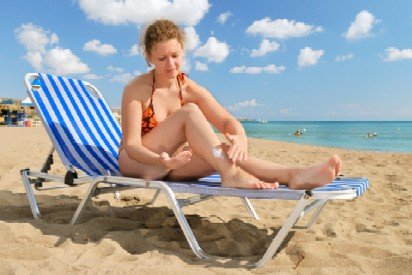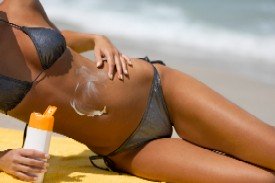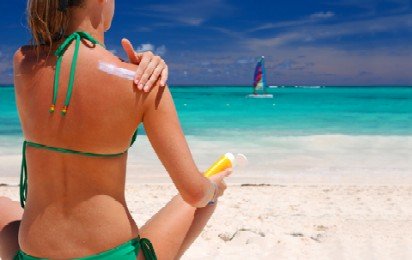Sun Protection Lotion Spf 30
Sun Protection is a fact of life™
Why You Need Sun Protection Lotion SPF 30 ?
Sun protection is not something you should take lightly. The sun emits harmful ultraviolet (UV) rays that can cause skin damage, premature aging, and skin cancer. According to the American Academy of Dermatology, one in five Americans will develop skin cancer in their lifetime. That's why it's important to protect your skin from the sun every day, not just when you're at the beach or on vacation.
One of the most effective ways to protect your skin from the sun is to use a sun protection lotion with SPF 30 or higher. SPF stands for sun protection factor, and it measures how well a product can protect your skin from UVB rays, which are the main cause of sunburn and skin cancer. The higher the SPF, the more protection you get.
But what does SPF 30 mean exactly? It means that if you apply the product correctly and generously, it will take 30 times longer for your skin to burn than if you didn't use any product at all. For example, if your skin normally burns in 10 minutes without any protection, using a sun protection lotion SPF 30 will extend that time to 300 minutes (5 hours). However, this doesn't mean you can stay in the sun for 5 hours without reapplying. You should reapply your sun protection lotion every two hours or more often if you sweat, swim, or towel off.

Another thing to keep in mind is that SPF only measures protection against UVB rays, not UVA rays. UVA rays are also harmful and can penetrate deeper into your skin, causing wrinkles, sagging, and dark spots. To protect your skin from both UVA and UVB rays, you should look for a product that is labeled as "broad spectrum" or has a UVA protection rating of PA+++ or higher.
Some of the benefits of using a sun protection lotion SPF 30 are:
- It reduces your risk of developing skin cancer and other skin diseases.
- It prevents sunburn and reduces inflammation and redness.
- It slows down the signs of aging and keeps your skin looking young and healthy.
- It prevents hyperpigmentation and uneven skin tone.
- It enhances your natural skin barrier and moisturizes your skin.
To get the most out of your sun protection lotion SPF 30, you should follow these tips:
- Apply it at least 15 minutes before going outside to allow it to absorb into your skin.
- Use about an ounce (a shot glass) of product to cover your entire body.
- Don't forget to apply it on areas that are often overlooked, such as your ears, neck, hands, feet, and scalp.
- Reapply it every two hours or more often as needed.
- Avoid exposure to the sun during peak hours (10 a.m. to 4 p.m.) when the UV rays are strongest.
- Wear protective clothing, such as hats, sunglasses, and long sleeves, to cover your skin.
- Seek shade whenever possible and avoid direct sunlight.

The Drawbacks of Sun Protection Lotion SPF 30
Sun protection lotion is a product that many people use to protect their skin from the harmful effects of ultraviolet (UV) radiation. SPF stands for sun protection factor, and it indicates how well the lotion can block UV rays. SPF 30 means that the lotion can block 97% of UVB rays, which are the ones that cause sunburn and skin cancer.
However, sun protection lotion SPF 30 is not a perfect solution for sun safety. There are some drawbacks that you should be aware of before you apply it on your skin. Here are some of them:
- It does not block UVA rays. UVA rays are the ones that penetrate deeper into the skin and cause premature aging, wrinkles, and sagging. They also contribute to skin cancer risk. Sun protection lotion SPF 30 only blocks UVB rays, but not UVA rays. To protect yourself from both types of UV rays, you need to look for a lotion that has broad-spectrum protection or contains ingredients like zinc oxide or titanium dioxide.
- It can give you a false sense of security. Some people may think that using sun protection lotion SPF 30 means that they can stay in the sun for longer without getting burned or damaged. This is not true. The SPF number only tells you how long it takes for your skin to burn compared to when you are not wearing any lotion. For example, if your skin normally burns in 10 minutes without lotion, then using SPF 30 will extend that time to 300 minutes (10 x 30). However, this does not mean that you are safe from the cumulative effects of UV exposure, which can lead to skin cancer and other problems. You still need to limit your time in the sun and seek shade when possible.
- It can expire or lose its effectiveness. Sun protection lotion SPF 30 has a shelf life of about two to three years, depending on how it is stored and used. If you keep it in a hot or humid place, or if you expose it to direct sunlight, it can degrade faster and lose its ability to block UV rays. You should always check the expiration date on the bottle and replace it if it is past due. You should also apply it generously and evenly on your skin at least 15 minutes before going outside, and reapply it every two hours or more often if you sweat or swim.
- It can cause allergic reactions or irritation. Some people may be sensitive or allergic to some of the ingredients in sun protection lotion SPF 30. These ingredients may include fragrances, preservatives, colorants, or chemical filters like oxybenzone or avobenzone. If you have a history of skin allergies or eczema, you should do a patch test before using any new lotion. Apply a small amount on your inner arm and wait for 24 hours to see if you develop any rash, itching, swelling, or redness. If you do, stop using the lotion and consult your doctor.
- It can harm the environment. Some of the chemical filters in sun protection lotion SPF 30 can be harmful to aquatic life and coral reefs. When you swim or shower with the lotion on your skin, some of it can wash off and enter the waterways. These chemicals can accumulate in the tissues of fish and other marine animals, and disrupt their hormonal balance and reproduction. They can also cause coral bleaching, which is when corals lose their color and die. To reduce your environmental impact, you should look for a lotion that is biodegradable or reef-safe.
These are some of the drawbacks of sun protection lotion SPF 30 that you should consider before using it. While it is important to protect your skin from UV rays, you should also be aware of the potential risks and limitations of this product. You should always follow the instructions on the label and use other sun safety measures like wearing a hat, sunglasses, and protective clothing.
Conclusion:
Using a sun protection lotion SPF 30 is one of the best things you can do for your skin health and appearance. By following these guidelines, you can enjoy the sun safely and confidently.
Join in and share your experience or story. How?
Simply click here to go to Sun Protection Reviews.
Return to Home Page Return to the Top









New! Comments
Have your say about what you just read! Leave me a comment in the box below.